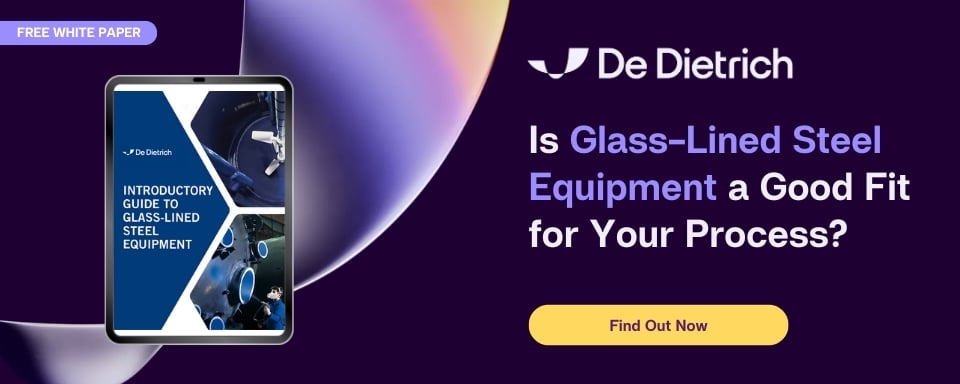Designing a Glass-Lined Vessel: How to Specify a Reactor [Part 3]

Editor’s Note: This post was originally published in January 2015 and has been updated for accuracy, clarity, and to reflect the latest information.
In the first two parts of this series, we reviewed the key details in our Glass-Lined Reactor Specification Form that help us design and quote a vessel tailored to your process. In Part 1, we discussed vessel size, material of construction, and design standards. In Part 2, we covered working conditions, environmental considerations, exterior finishes, and jacket arrangements.
In this final installment, we’ll focus on mixing systems and peripheral equipment—two areas that play a major role in your reactor’s performance and efficiency.
Agitation System
Selecting the right agitation system is critical for achieving the desired mixing, heat transfer, and reaction results in your process. Things to consider include:
- Drive
- Agitator
- Mechanical Seal
- Baffle
Drive
- Drive Type – Choose between fixed speed for consistent processes or variable speed via an inverter for flexible operation. Some processes benefit from peripherals like a revolution counter (electronic) or tachometer (mechanical), which can be offered along with your drive.
- Size - The motor and drive size will be determined based on your reactor model and size.
- Rotation - All drives can perform clockwise or counterclockwise rotation of the agitator.
Agitator
The choice depends on your product’s viscosity, shear sensitivity, and desired flow pattern.
- Traditional Welded Blades– Options include anchor, turbine, or retreat curve impellers.
- Removable and Variable Pitch Blades – De Dietrich GlasLock® agitator with blade designs available for flat, trapezoidal, breaker bar, HydroFoil®, OptiFoil®, or ViscoFoil®.
- Options
- For easy visual detection of liquid levels, calibration lines can be added to the agitator shaft.
- Agitators can be designed to reduce space between the blades and the bottom of the vessel in the case of processes that require minimum agitated volumes.
- Mixing simulations dedicated to your customized parameters are available upon your request.
Mechanical Seals and Bearings
To protect your product and equipment, seal selection is equally important. We offer:
- De Dietrich OptiSeal is the standard dry-running seal design on De Dietrich glass-lined reactors that meets the stringent process requirements of today’s pharmaceutical and chemical manufacturing environments. This innovative seal design is comprised with stainless steel housing and helps users establish compliance with USP (U.S. Pharmacopeial Convention) and BPE (ASME Bioprocessing Equipment) guidelines.
- Lubricated designs are also available depending on process needs.
Baffles and Dip Pipes
Baffles help control vortex formation, improve mixing uniformity, and enhance heat transfer. We can design them to be removable for cleaning or fixed for permanent installation. (OptiMix wall-mounted baffles are an additional option for processes that benefit from optimized mixing and heat transfer).
- Removable Design – The two options are Beavertail Baffle or a baffle combined with a dip pipe. A thermoprobe that enables reliable in-process temperature measurement is available in both models.
- Fixed Design - OptiMix wall-mounted baffles are an additional option for processes that benefit from optimized mixing and heat transfer.
- Dip Pipe - If you select a dip pipe to be installed, you’ll have to decide on the length, material of construction (glass-lined, PTFE, or other) and we will confirm if the design is feasible and adequate for the agitation forces (if agitated vessel).
Peripheral Components
Additional components can be integrated into your reactor such as:
- Sampling baffle BLE with or without pH measurement
- TSU sampling system with or without pH measurement
- Electrode Holder Probe GPE 100
- Endress+Hauser level measurement
- Endress+Hauser level switch
- GlasWatch for continuous monitoring of the glass with electrodes (installed in valve, spacer probe or baffle)
- Spray ball (PTFE, Hastelloy C-22, other Alloy)
- Other glass-lined equipment
Installation and Commissioning Support
Once your reactor is fabricated, proper installation and startup are essential for long-term performance. De Dietrich offers:
- On-site installation guidance
- Start-up and commissioning services
- Training for your operators and staff for preventative maintenance
Final Steps to Your Specification
By providing clear and complete information in your Glass-Lined Reactor Specification Form, you enable us to engineer a vessel that fits your process perfectly—from the mixing system inside to the environmental protections outside.
This concludes our three-part series on specifying a glass-lined reactor. From the fundamentals of vessel size and materials (Part 1), to operational and environmental considerations (Part 2), and finally to mixing systems and peripheral equipment (Part 3), we’ve explored every section of our Glass-Lined Reactor Specification Form.
By gathering and sharing this information early in the quoting process, you’ll save time, streamline design decisions, and ensure your vessel is optimized for your process from day one.
If you missed the earlier posts, you can catch up here:
Ready to start your own project? Download the Glass-Lined Reactor Specification Form or contact De Dietrich to discuss your requirements with our team.
